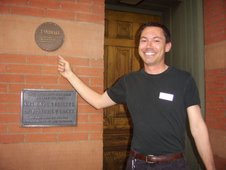Recently I've been researching aspects of Denver's lost residential neighborhoods of yesteryear. It may surprise most of you to know that downtown Denver and its adjacent neighborhoods were once filled with lovely residences and some not so lovely residences--housing of all types. Many of the parking lots we see in and around downtown today were once occupied by homes. Some of these houses were later supplanted by businesses. The last home standing in central downtown is the Curry-Chucovich-Gerash House at 1439 Court Place on Block 207.
To get a sense of what this neighborhood near the Arapahoe County Courthouse once looked like, here is a picture circa 1890 to get us in the right frame of mind:

This area, between Tremont and Glenarm Places, features a now rare Second Empire designed home. That is the house with the mansard style roof. Hidden in the trees to the right is the Curry-Chucovich-Gerash House, circa 1888 with the Arapahoe County Courthouse dominating the skyline.
Just down the street at 1308 Glenarm stood the Amos Steck House:

Mr. Steck was on the first Denver School Board. He gave land to the East Denver School District that was eventually used to build the first permanent school building in Denver, the Arapahoe School.
Aside from Curtis Park, which remains remarkably intact north of 23rd Street, there isn't much residential remaining south of that line, except for the random house here and there in the Arapahoe Square area. One nearly intact block remains however. Staving off demolition during the mid-1970s when its neighborhing blocks were bull-d0zed to make way for the 1976 Winter Olympics Housing, this block formed the Clement's Historic District. Compare this link of the current street with what we can see of some of the 2100 block over a century ago:
The neighborhoods to the south of downtown didn't fair much better. The residences of today's Golden Triangle or Civic Center neighborhood was even more obliterated during the 20th century, first to make way for Civic Center Park, and secondly to make way for libraries, art museums, parking lots and associated businesses. The neighborhood lost so much population that by 1973, the Denver Public Schools closed down the area school: Evans Elementary. That building still stands today but is not in use. Recently, an old picture made its way to the Byers-Evans House Museum (circa 1883). This picture was interesting because it showed people smiling in front of homes that were long ago demolished to make way for the Denver Art Museum's North Building (circa 1971 by Gio Ponti). The only hold-outs from that construction project were the Evans sisters, granddaughters of Colorado's second territorial governor, John Evans. They stayed put and today, their house is a museum (and my workplace). The picture of their neighbor's house to the north at 1316 Bannock is quite a treasure to see today:
All black and white historic photos are from the Denver Public Library's Western History Collection except for the picture of 1316 Bannock.



2 comments:
Shawn,
Thanks for these historical posts! I appreciate the work and care you put into them, and I'm finding them really interesting.
Vicki from Uptown
Thanks for the great post. It's not really technically downtown, but I'd also add a more recent loss of (near) downtown housing: Auraria. They bulldozed a lot of houses to build that campus.
Post a Comment